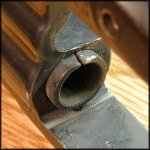I have asked about model 66 problems shooting 357's, on this, and other boards, for years.
I use to ask in those posts if anyone had ever seen or even HEARD of a cracked forcing cone on a model 66. After all those years of asking, I finally got one taker. About four years back a fellow posted a picture here of a cracked forcing cone on a 66. He said he did it with factory 125 grain 357's.
He didn't say what brand and IIRC didn't respond to follow up questions. From the photo I discerned that the revolver was dirty with carbon buildup around the forcing cone.
If you don't clean your revolver properly, and allow it to build up lead and carbon in and around the forcing cone, AND you shoot high volumes of lead followed by untold high volumes of hot 125 grain jacketed 357's, you MIGHT crack a forcing cone on a model 66. Of course by the time you do, you could easily have purchased a replacement pre lock 66 (at todays prices) with all the money you spent on ammunition.
I have 13 model 66's. If the design was as "weak" as alleged on the internet gun boards, I would have seen it in over 44 years of shooting K-frame magnums. Could it happen? Sure. Has it happened? Yea I'm sure it has. Does it happen with any frequency? I havent seen one scintilla of evidence that it does. To the contrary, it appears to be an extremely rare event.
The high time examples in my herd are both former LE guns with untold amounts of 357 through them. The 4 inch 66-2 has over 25,000 125 grain 357's through it from its service career with a Chicago cop. He was a shooter and told me what he'd run through it.
I've used it in IDPA, carried it on duty, qualified with it several times and taught new shooters with it. I have put at least another 4000 357's through it and untold numbers of 38+P over the years. It has only started to exhibit a slight bit of endshake over the last few years. Very little rotational slop. Trigger is smooth and sweet. There is some flame cutting on the top strap as you would expect. That is self limiting in my experience and not a concern, to me. The gun locks up tight and is a tack driver.
I may send it off to Sandburr Ranch for a tune up and to remove the endshake. I also may not as the gun operates perfectly and locks up tight.
So OP, go and enjoy that 66-1 shooter. It is a fine example of what S&W was capable of building. Possibly the finest revolver to come out of Springfield. There won't be any more as nice either. Keep it clean, shoot what you can handle/want/afford, and your great grandkids will be enjoying that fine revolver.

Good luck! Regards 18DAI





